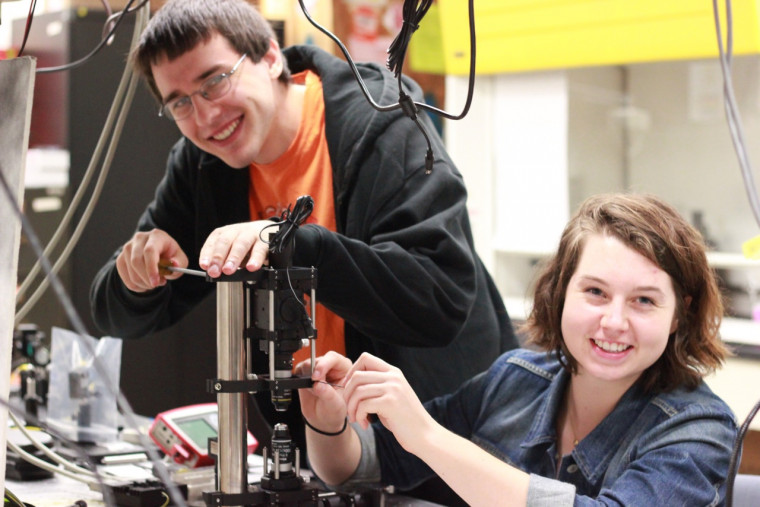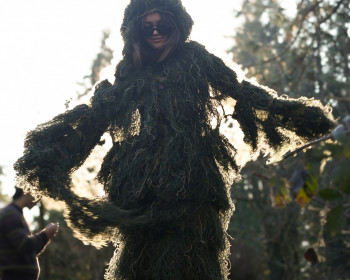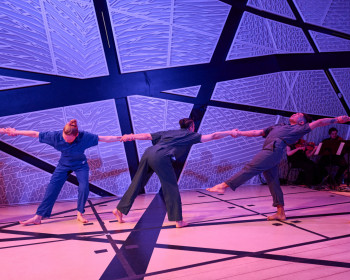Students use holographic tweezers to study microscopic bubbles
Open gallery

During the summer, Lewis & Clark students continue to work hard in their fields of study. By collaborating with faculty on research projects, students are able to engage their curiosity, expand their learning, and prepare for life after college, all while making meaningful contributions to scholarship.
Amaya Lucas ’15 and Reuben Peterson ’14 are working with Assistant Professor of Physics Shannon O’Leary to discover whether or not holographic optical tweezers are well suited in the study of microscopic bubbles. In the following Q&A, the team members reflect on their experience.
What are you researching? What question or problem are you trying to answer/solve with your research?
We are investigating optical tweezers, which are a device used to trap and move particles with a sharply focused laser. We are trying to determine if the tweezers would be well suited to assist the study of the dynamics of microscopic bubbles. These microbubbles are currently used for medical imaging but have great potential for many future medical applications.
Does your research have any potential applications in the real world, or will it influence other work in your field?
Optical tweezers are currently used extensively in the study of microscopic particles. They have well known biological applications, as the trapped particle can be bacteria, DNA, or even a specific organelle within a cell. On the other hand, using optical tweezers to study microbubbles is a very recent idea that has not yet gained significant scientific attention. Therefore, any work confirming their potential may strongly influence future efforts to study microbubbles.
What first sparked your interest in this research area?
When we learned about the optical tweezers, we were very intrigued to discover that light, a massless photon, can move a comparatively massive particle through simple refraction. This mechanism is the dominant force behind how optical tweezers work and is pretty incredible.
How has working closely with faculty influenced your education?
In working with Shannon on this project, we have had the opportunity to investigate difficult subjects that we would not ordinarily cover. We greatly benefit from her experience since she is always willing to share stories of her graduate studies and give advice on future challenges we may face. Shannon is very approachable and we frequently come to her with physics questions completely unrelated to our project.
How do you hope your experiences this summer will impact your future studies or professional pursuits?
This experience has served as an excellent introduction to academic research. We have gained invaluable skills in problem solving, data acquisition and analysis, and presentation of findings. The new exposure to optical physics is very exciting and we are both interested in studying it further. Finally, this opportunity has enabled us to develop an aptitude for independent research that we hope to employ throughout our careers.
About the program
The John S. Rogers Science Research Program allows students to participate in graduate-level research with an emphasis on strengthening their communication skills by requiring them to present their findings. This summer, 40 students are pursuing topics that range from artificial intelligence and motivating behavior to holographic tweezers and zebra fish. Working closely with peers and faculty members, students undertake research questions and present their work in two public venues.
“We’re not asking you, ‘What’s the answer?’ We’re saying, ‘What’s the question?’” said Michael Broide, director of the Rogers program and chair of the physics department. “I think what sets our program apart is that regardless of what project you are on, we’re all going to come together as a group to present what we’re doing in as accessible a way as possible. In science, it’s such an important skill to be able to explain cogently what you’re doing.”
Students make their final research presentation at the Rogers summer science poster session, held in conjunction with the Science Without Limits Symposium. Scheduled for September 18, the poster session is free and open to the public.
Department of Physics Rogers Summer Research Projects
Zibby Pillote ’14 contributed to this story.
More Newsroom Stories
Public Relations is located in McAfee on the Undergraduate Campus.
MSC: 19
email public@lclark.edu
voice 503-768-7970
Public Relations
Lewis & Clark
615 S. Palatine Hill Road MSC 19
Portland OR 97219

